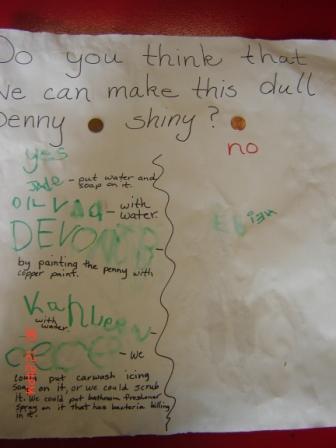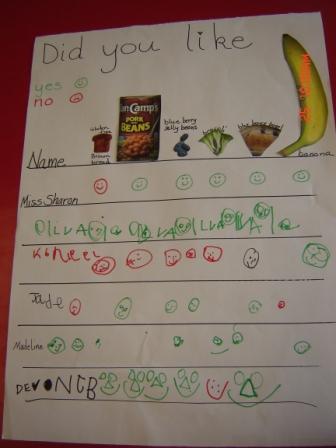Classroom charts provide many opportunities for learning, as well as conveying to children the importance of their opinions. Miss Sharon’s class recently used two different examples of charting to extend and document two classroom activities. See photos of the charts at the end of the blog.
The Robins’ class recently had a taste test of foods whose names begin with the letter “B.” Following the activity the children used happy and sad faces to indicate whether they liked or disliked the food. They then used the graph to make observations about their classmates and the foods they tasted.
The other chart was used to help children make a scientific prediction about the possiblity of turning a dirty, dull penny into a clean, shiny penny. The children were so fascinated with the question they took it upon themselves to come up with their own experiments. Olivia and Kahleel used water alone to soak the penny. Jade added soap to the water. All three of them concluded that soap and water may have cleaned the penny but, it didn’t make it shiny. Cece’s ideas held much promise, but unfortunately the supplies were not available. She suggested using carwash icing soap on it and then scrubbing it. She also suggested bathroom freshner that has bacteria killer in it. Devon’s idea to repaint the penny with copper paint – was a success! The children also discovered that vinegar, is cleaning agent. In addition to the copper paint, soaking the penny in vinegar cleaned and shined the copper penny too.
There were many, many examples of “hands on learning” in the above activities which used classroom charts. First of all, and not to be overlooked, is the lesson to each child that they and their ideas are valued. Secondly, children are writing for a purpose. They not only must give thought to the question and make a decision about how they will answer it; they must then follow the directions and record their answer correctly. Of course, the fine motor practice is beneficial as well.
Besides the thinking and the fine motor practice, both charts provided opportunities for scientific and mathemathetical reasoning and observation skills. One of the main purposes of classroom charts are the daily practice and exposures to reading processes and letter and word recognition. Classroom charts are a part of the daily routine in the Robin and Bluebird classes. Who said learning can’t be fun?



 Schedule Tour
Schedule Tour